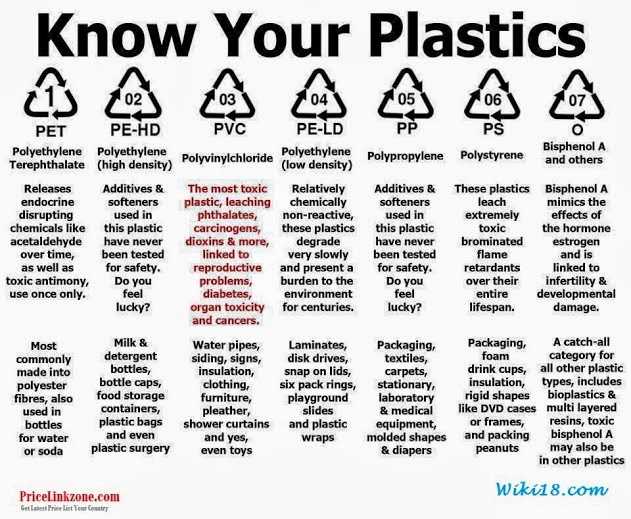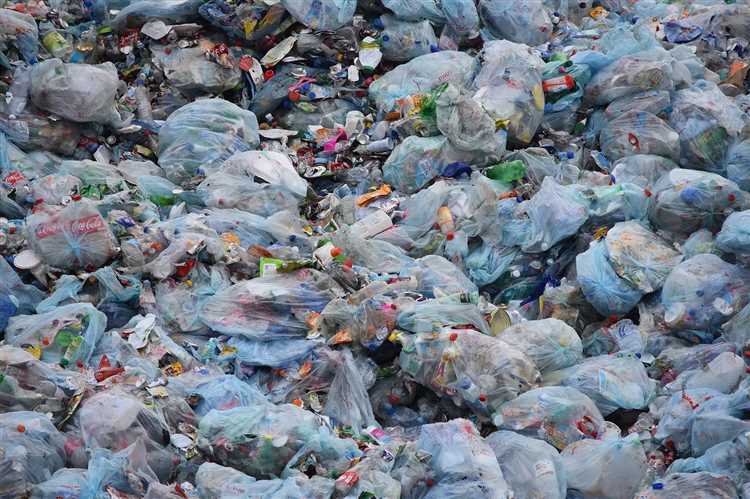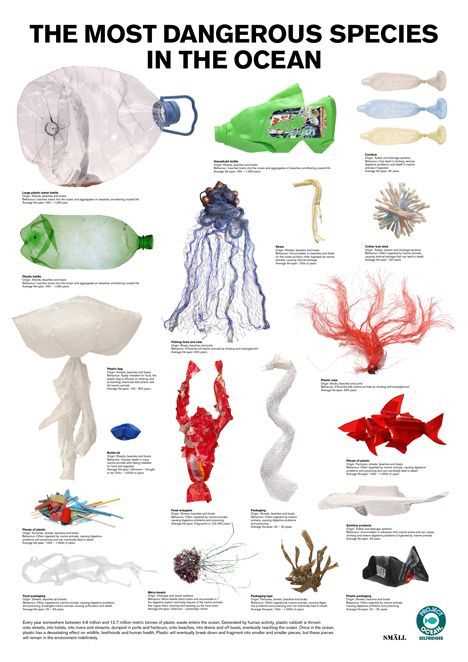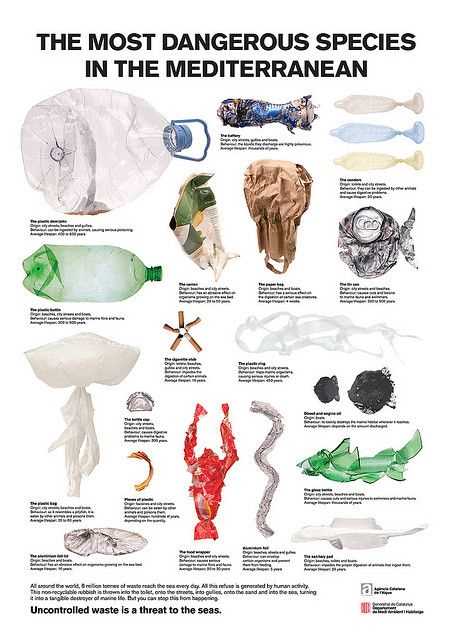
Plastic pollution has become one of the most pressing environmental issues of our time. Every year, millions of tons of plastic waste end up in our oceans, landfills, and natural habitats, causing catastrophic harm to wildlife and ecosystems.
While all types of plastic contribute to this crisis, there are certain types that are particularly damaging and have a significant environmental impact. Understanding these harmful plastic types is crucial in order to develop effective strategies to tackle plastic pollution and move towards a more sustainable future.
One of the most harmful plastic types is single-use plastic, such as plastic bottles, bags, and straws. These items are designed to be used once and then thrown away, but they can take hundreds of years to decompose. As a result, they accumulate in our environment and contribute to the growing problem of microplastic pollution.
Microplastics are tiny plastic particles that are less than 5 millimeters in size. They are present in various forms, such as microbeads from cosmetics, fibers from clothing, and fragments from larger plastic items that have broken down over time. These microscopic particles are almost impossible to remove from the environment and have been found in the most remote and pristine areas of the planet, including the depths of the ocean and the Arctic.
Another damaging plastic type is polystyrene, commonly known as styrofoam. This lightweight material is used in the production of disposable food and beverage containers, insulation, and packaging materials. It is not only non-biodegradable, but also difficult to recycle due to its chemical composition. As a result, polystyrene waste often ends up in landfills or is incinerated, releasing toxic chemicals into the air and contributing to air pollution.
Exploring the most damaging plastic types and their environmental impact is crucial in finding sustainable solutions to the global plastic pollution crisis. By raising awareness about the harm caused by single-use plastics, microplastics, and polystyrene, we can encourage individuals, businesses, and governments to adopt more environmentally friendly alternatives and reduce their plastic consumption. It is time to take action and protect our planet from the devastating consequences of plastic pollution.
- The Hazards of Single-Use Plastics
- Environmental Impact
- Health Concerns
- Understanding the Dangers of Microplastics
- Examining the Environmental Consequences of Plastic Packaging
- Assessing the Impact of Plastic Pollution on Marine Life
- Evidence of Plastic’s Harmful Effects
- Impacts on Ecosystems
- Investigating the Long-Term Effects of Plastic Waste Disposal
- Finding Sustainable Solutions to Plastic Pollution
- Q&A:
- Why are some plastic types more damaging to the environment?
- What are the most damaging plastic types?
- Why is polystyrene damaging to the environment?
- How does PVC affect the environment?
The Hazards of Single-Use Plastics

Single-use plastics, also known as disposable plastics, refer to items that are used once and then discarded. These items include but are not limited to plastic bags, straws, water bottles, and food packaging. While they may seem convenient in the moment, single-use plastics pose significant hazards to our environment and society.
Environmental Impact
One of the primary hazards of single-use plastics is their negative environmental impact. These plastics are not biodegradable and can persist in the environment for hundreds of years. As a result, they accumulate in landfills, oceans, and other natural habitats, causing harm to wildlife and ecosystems.
The production of single-use plastics also contributes to greenhouse gas emissions and the depletion of natural resources. The extraction of fossil fuels, which are used as raw materials for plastic production, leads to carbon emissions, air pollution, and habitat destruction.
Health Concerns

Furthermore, single-use plastics can pose health risks to humans. Many of these plastics contain harmful additives and chemicals, such as phthalates and bisphenol A (BPA), which can leach into food and beverages. These chemicals have been linked to various health issues, including hormone disruption and reproductive problems.
Additionally, the process of manufacturing single-use plastics often involves the release of toxic pollutants and emissions, which can contaminate air and water sources. This pollution can have detrimental effects on human health, especially for communities living near plastic manufacturing facilities.
| Issue | Hazard |
|---|---|
| Plastic Pollution | Accumulation in landfills, oceans, and natural habitats |
| Greenhouse Gas Emissions | Contribution to climate change |
| Resource Depletion | Extraction of fossil fuels for plastic production |
| Chemical Leaching | Potential exposure to harmful additives and chemicals |
| Toxic Pollution | Release of pollutants during manufacturing |
Given these hazards, it is crucial that we take steps to reduce our reliance on single-use plastics. This can be done through implementing policies and regulations that promote the use of sustainable alternatives, as well as individual actions such as choosing reusable products and supporting businesses that prioritize eco-friendly practices.
Understanding the Dangers of Microplastics

Microplastics are tiny plastic particles that measure less than 5 millimeters in length, making them almost invisible to the naked eye. These particles come from a variety of sources, including the breakdown of larger plastic items, fibers from synthetic clothing, microbeads in personal care products, and industrial processes.
While microplastics may be small, they pose a significant threat to the environment and human health. The sheer quantity of microplastics in the environment is a cause for concern. It is estimated that there are trillions of microplastic particles present in the oceans alone.
Marine life is particularly vulnerable to the dangers of microplastics. These tiny particles can be mistaken for food by marine organisms, leading to ingestion and potential internal damage. As microplastics move up the food chain, they can accumulate in larger and more complex organisms, ultimately reaching humans through seafood consumption.
Additionally, microplastics have the ability to absorb and concentrate harmful chemicals from their surroundings. These chemicals can include heavy metals, pesticides, and other toxins. When ingested by marine animals or ultimately humans, these chemicals can have detrimental effects on health, such as hormonal disruptions, reproductive issues, and developmental abnormalities.
Microplastics also have the potential to leach harmful chemicals when they come into contact with water or are consumed. This can further contribute to the pollution and contamination of both terrestrial and aquatic ecosystems.
Furthermore, the impact of microplastics extends beyond the environment and human health. They can also have negative economic consequences, such as clogging waterways, damaging infrastructure, and affecting tourism industries.
In conclusion, understanding the dangers of microplastics is essential in addressing the plastic pollution crisis. Taking measures to reduce the production and consumption of single-use plastics, implementing proper waste management systems, and promoting alternative materials are crucial steps in mitigating the risks associated with microplastics.
Examining the Environmental Consequences of Plastic Packaging
Plastic packaging, although widely used and convenient, presents a significant environmental challenge. The disposal and decomposition of plastic packaging contribute to pollution and harm ecosystems in various ways.
One of the major consequences of plastic packaging is marine pollution. Plastic materials, including packaging, make their way into oceans and waterways, posing a threat to marine life. Marine animals can mistake plastic packaging for food, leading to ingestion and entanglement, which often results in injury or death. Moreover, the breakdown of plastic packaging into microplastics further spreads pollution throughout the marine ecosystem, affecting aquatic organisms at the microscopic level.
Plastic packaging also contributes to land pollution. Improper disposal and inadequate recycling of plastic packaging lead to it accumulating in landfills or ending up as litter in the environment. Plastic waste in landfills can release harmful chemicals and contaminate soil and groundwater, posing risks to human health and the ecosystem. Additionally, plastic packaging litter can disrupt natural habitats, harm wildlife, and detract from the aesthetic beauty of landscapes.
The production of plastic packaging has its own environmental impact as well. The extraction and processing of raw materials for plastic production requires significant energy and resources, contributing to greenhouse gas emissions and depletion of natural resources. The manufacturing process also generates air and water pollution, further contributing to environmental degradation.
To mitigate the environmental consequences of plastic packaging, various solutions have been proposed. These include promoting the use of sustainable packaging materials, such as biodegradable or compostable alternatives. Encouraging responsible disposal and effective recycling practices can also reduce the accumulation of plastic packaging waste. Furthermore, supporting initiatives and policies that incentivize the reduction of plastic packaging and promote circular economy principles can help minimize its environmental impact.
Examining the environmental consequences of plastic packaging is essential to drive awareness and promote sustainable practices. By understanding the negative impacts of plastic packaging, individuals, industries, and policymakers can work towards finding viable solutions and adopting more environmentally friendly alternatives.
Assessing the Impact of Plastic Pollution on Marine Life
Plastic pollution in the world’s oceans is a significant threat to marine life. As plastic waste accumulates in the water, it poses a wide range of dangers to various marine species. Understanding the impact of plastic pollution is crucial in developing effective strategies to reduce its effects.
Evidence of Plastic’s Harmful Effects
Extensive research has shown that marine animals, including fish, seabirds, turtles, and marine mammals, are significantly affected by plastic pollution. Plastic debris is often mistaken for food, leading to ingestion and obstruction of the digestive system, preventing these animals from obtaining essential nutrients.
Ingested plastic can also release toxic chemicals into an animal’s body, leading to long-term health issues and even death. Additionally, marine animals can become entangled in plastic debris, causing severe injuries, stress, and hampering their ability to swim, fly, or feed efficiently.
Impacts on Ecosystems
The presence of plastic waste in marine environments disrupts fragile ecosystems and poses a threat to biodiversity. As plastic fragments break down into microplastics, they permeate the food chain, with potential impacts on organisms at every trophic level.
Marine organisms, from plankton to larger predators, can mistakenly consume microplastics, contributing to bioaccumulation and biomagnification. This process can lead to harmful effects not only on individual animals but on entire ecosystems, causing a disruption in food webs and natural ecological balance.
To assess the overall impact of plastic pollution on marine life, ongoing monitoring programs are essential. Scientists collect data on the quantities of plastic debris, the types of plastics found, and the distribution patterns to evaluate the severity of the problem. This information helps identify hotspot areas and guides efforts to develop effective mitigation strategies and policies to combat plastic pollution.
Investigating the Long-Term Effects of Plastic Waste Disposal
Plastic waste disposal poses a significant threat to the environment, with long-term effects that can be detrimental to both ecosystems and human health. As plastics break down over time, they release toxic chemicals into the air, water, and soil, leading to pollution and harming various forms of life.
When plastic waste is improperly disposed of in landfills or dumped into oceans, it can take hundreds of years to decompose. During this time, the plastic breaks into smaller and smaller pieces known as microplastics. These microplastics eventually end up in the environment and are ingested by wildlife, including fish, birds, and marine mammals. The ingestion of plastic can result in physical harm, intestinal blockages, and even death.
The long-term effects of plastic waste disposal extend beyond just wildlife. Microplastics have been found in tap water, bottled water, and even in the air we breathe. These particles can be inhaled or ingested by humans, potentially leading to health issues such as respiratory problems, hormone disruption, and carcinogenic effects.
Furthermore, the accumulation of plastic waste in landfills and oceans contributes to the overall pollution of these ecosystems. Plastics can release harmful chemicals into the soil, leaching toxic substances that can contaminate groundwater and affect plant growth. In oceans, plastics can entangle marine life and disrupt natural habitats, leading to negative impacts on biodiversity.
To address the long-term effects of plastic waste disposal, it is crucial to promote effective waste management strategies and reduce plastic consumption. Recycling and proper disposal methods can help minimize the accumulation of plastic in landfills and oceans, reducing its long-term environmental impact. Additionally, developing and adopting alternative materials that are biodegradable or have a lower environmental footprint can help mitigate the long-term effects of plastic waste disposal.
Finding Sustainable Solutions to Plastic Pollution
Plastic pollution has become a global crisis, with tons of plastic waste ending up in our oceans and landfills each year. To address this pressing issue, it is crucial for us to find sustainable solutions that can help minimize the environmental impact of plastic.
Reducing single-use plastics: One effective way to tackle plastic pollution is by reducing our consumption of single-use plastics. This includes items such as plastic bags, straws, and water bottles. By making small changes in our daily lives, such as carrying reusable bags and using refillable water bottles, we can significantly decrease the amount of plastic waste that ends up in the environment.
Promoting recycling and waste management: Proper recycling and waste management are essential in combating plastic pollution. Government and community-led initiatives can help educate and encourage individuals to recycle their plastic waste correctly. Implementing comprehensive recycling programs and improving waste collection systems can also make a significant difference in reducing plastic pollution.
Investing in innovative technologies: The development of new and innovative technologies is another key aspect of finding sustainable solutions to plastic pollution. This includes advancements in recycling technology, such as chemical recycling, which can convert plastic waste into valuable resources. Additionally, investing in research and development for alternative materials to replace plastics can also contribute to reducing plastic pollution.
Advocating for policy changes: Governments play a crucial role in addressing plastic pollution by implementing and enforcing effective policies. This can include banning single-use plastics, imposing taxes on plastic products, and promoting Extended Producer Responsibility (EPR) programs. By advocating for policy changes at various levels, we can create a more sustainable future with reduced plastic pollution.
In conclusion, finding sustainable solutions to plastic pollution requires collective efforts from individuals, governments, and industries. By reducing single-use plastics, promoting recycling and waste management, investing in innovative technologies, and advocating for policy changes, we can work towards a cleaner and more environmentally-friendly world free from the harmful impact of plastic pollution.
Q&A:
Why are some plastic types more damaging to the environment?
Some plastic types are more damaging to the environment because they take longer to decompose and can release harmful chemicals during the process. Additionally, certain plastic types are more likely to end up in the ocean or other natural habitats, causing harm to wildlife.
What are the most damaging plastic types?
The most damaging plastic types include polystyrene (commonly known as Styrofoam), polyvinyl chloride (PVC), and polyethylene terephthalate (PET). These plastics are difficult to recycle, take hundreds of years to decompose, and can release toxic chemicals.
Why is polystyrene damaging to the environment?
Polystyrene is damaging to the environment because it is not easily biodegradable and can take hundreds of years to decompose. It is also lightweight, which means it can easily be carried by wind and water and end up in oceans or other natural habitats, causing harm to marine life.
How does PVC affect the environment?
PVC affects the environment in several ways. It is made from toxic chemicals, which can be released during its manufacturing and incineration. PVC also takes a long time to decompose and is difficult to recycle, leading to the accumulation of this plastic type in landfills and natural habitats.